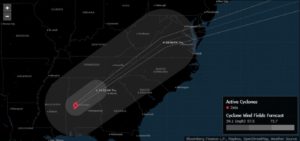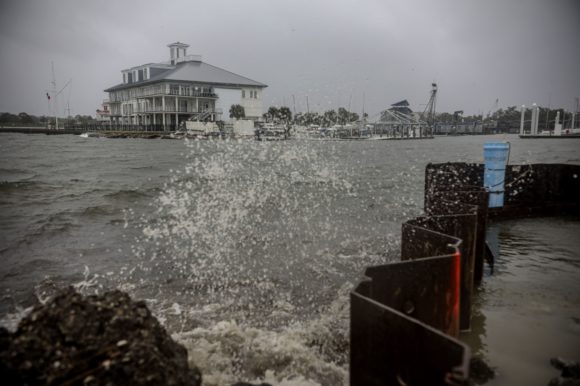Tropical Storm Zeta is spinning across the U.S. South after walloping New Orleans, blacking out 1.9 million homes and businesses and leaving a trail of wreckage from Louisiana to North Carolina.
Zeta made landfall near Cocodrie, Louisiana, with winds of 110 miles (177 kilometers) per hour, before weakening to 60 mph, according to the National Hurricane Center. It’s the fifth hurricane or tropical storm to hit the state this year. There’s never been so many major storms hitting Louisiana or the contiguous U.S. in a single season, said Phil Klotzbach, a hurricane researcher with Colorado State University.
Zeta tore through New Orleans at a brisk 31 miles an hour, leaving at least one dead in its wake. Damages may still total as much as $5 billion. There has been no major flooding, New Orleans officials said at a press conference late on Wednesday. Trees and utility poles have snapped, and the main impact so far is the widespread power outages.
“It is moving briskly and that is good news,” said Rob Miller, a meteorologists with commercial-forecaster AccuWeather Inc. “It is racing quickly and moving away quickly.”
 Zeta, which was over North Carolina at 8 a.m. local time, is the latest in a grim parade of natural disasters to hit the U.S. in recent months as climate change makes weather increasingly extreme. In California, heat waves, drought and violent winds have combined to fuel a rash of wildfires that have burned a record 4.1 million acres this year. And along the East and Gulf coasts, a record 11 named storms have hit the U.S.
Zeta, which was over North Carolina at 8 a.m. local time, is the latest in a grim parade of natural disasters to hit the U.S. in recent months as climate change makes weather increasingly extreme. In California, heat waves, drought and violent winds have combined to fuel a rash of wildfires that have burned a record 4.1 million acres this year. And along the East and Gulf coasts, a record 11 named storms have hit the U.S.
In all, 27 storms have formed across the Atlantic in 2020. So many systems have formed this season that the National Hurricane Center has used up all its official titles and has resorted to the Greek alphabet to designate new ones.
The majority of the nearly 1.9 million outages are in Georgia, Louisiana, Alabama and Mississippi, according to PowerOutage.US, a website that aggregates utility outage data. The electrical failures knocked out traffic lights, and government officials warned residents to stay off the roads.
As the storm continues northeast toward Virginia, the biggest threat could be heavy rain across the Ohio Valley. A wide area could get as much as 4 to 8 inches, with some isolated spots in the Appalachians getting up to 12 inches, Miller said.
To the north of Zeta’s track, upstate New York and parts of New England will get their first snow of the season as the tropical moisture runs into cooler temperatures, Miller said. Boston could get about 1 inch, and Albany could see a dusting.
Zeta becomes only one of six storms to hit the U.S. this late in October and the first hurricane to do so since 1985, said Jeff Masters, a meteorologist with Yale Climate Connection. While Sandy was a powerful storm when it came ashore in New Jersey in 2012, it had lost its hurricane characteristics when it struck land.
Zeta grew in strength as it moved across the Gulf, and all through this year six storms have rapidly intensified — short of a record, but indicative of climate change.
“There have been a lot of rapidly intensifying storms and that is something we expect to see in a warming climate,” Masters said.
Zeta may cause as much as $5 billion in damages and losses, said Chuck Watson, a damage modeler at Enki Research, who raised his estimate from an initial $1 billion as the forecast worsened.
While the intensity and number of storms has surpassed the 12 that usually form in an average season, there is no indication things will stop as October ends and November begins.
A potential storm could form in the Caribbean Sea within the next week, which would be called Eta. This would be the 28th storm and tie a record with 2005 for the most in a single year.
–With assistance from Serene Cheong, Dan Murtaugh, Sharon Cho, Andrew Janes, Reinie Booysenand Rakteem Katakey.
About the photo: Waves crash over Lake Pontchartrain as Hurricane Zeta makes landfall on October 28, 2020 in New Orleans, Louisiana. Photographer: Sandy Huffaker/Getty Images North America
Was this article valuable?
Here are more articles you may enjoy.


 Musk’s xAI Faces California AG Probe Over Grok Sexual Images
Musk’s xAI Faces California AG Probe Over Grok Sexual Images  California Bill Would Require Insurer Claims Handling Plans, And Double Penalties
California Bill Would Require Insurer Claims Handling Plans, And Double Penalties  JPMorgan Wins Gender Pay Gap Dispute Against London Analyst
JPMorgan Wins Gender Pay Gap Dispute Against London Analyst  Palantir Poaching Suit Called ‘Scare’ Tactic by Ex-Employees
Palantir Poaching Suit Called ‘Scare’ Tactic by Ex-Employees 